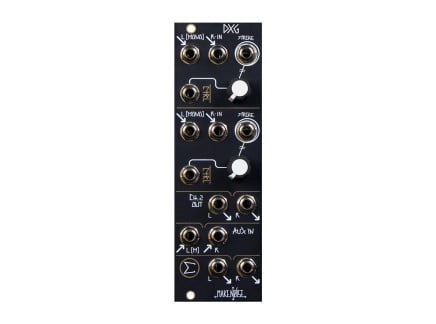In a surprise announcement reminiscent of the recent release of the DXG Dual Stereo Gate, Make Noise has introduced not one, but two new Eurorack modules: the Press Point and Channel Saver. These small utilities might look simple—and indeed, they're easy enough to wrap your head around—but they open up a ton of possibilities in nearly any Eurorack system. Not to mention, they're quite affordable—each ringing in at under $100 USD. So, if you need a touch of gestural control or some additional voltage processing for your system, these are well worth consideration.
Let's look at each of these modules individually to unpack what they do.
Make Noise PrssPnt (Press Point)
Press Point (PrssPnt) is the next evolution of Make Noise's touch controller concepts. Make Noise's Pressure Points—inspired by classic experimental synthesizer tools like the Serge Touch Activated Keyboard Sequencer (TKB) and the Buchla Model 217 Multiple Touch Controlled Voltage Source—is easily one of the most iconic controllers in the Eurorack modular synthesizer format. Using an array of capacitive touch plates, it provides users access to three rows of tuned voltages, touch "pressure" voltages, and touch "gates." With the inclusion of the now-discontinued Brains expander, it could also act as a sequencer. Of course, the Pressure Points concept was pushed to new heights with the ever-popular standalone 0-CTRL, which packed most of the Pressure Points+Brains functionality into a compact, self-contained package while bringing a host of new functions to the table.
The new module PrssPnt offers a new take on this functionality. While Pressure Points and 0-CTRL are based on the idea of using multiple individual plates to select between tuned voltages, PrssPnt is instead a "single channel/single stage" device intended to provide touch-derived continuous voltages and gates to your system. The two right-side gate outputs offer a momentary touch gate and a toggled gate. The former goes high as soon as you touch the bottom plate, and the latter alternates between high and low states with successive touches.
On the left side, you get two outputs derived from touch pressure. One is a direct pressure output, similar to what you'd get from a 0-CTRL or Pressure Points; the sensitivity panel control offers fine-tuning for its response. The second pressure output provides what Make Noise calls the Smooth Touch Function: a slewed version of the pressure signal. The second panel control alters the slew time—ultimately, allowing for smoothed touch control, touch "envelopes" with long decays, and much more. And of course, all of these functions are available simultaneously—turning PrssPnt, if desired, into a dynamic source of macro patch control.
Make Noise Ch.Svr (Channel Saver)
Channel Saver (Ch.Svr), on the other hand, is a utility voltage processing module that bears resemblance to the middle channels of Maths—effectively saving those middle channels for additional uses in your patch. Ch.Svr can perform polarization, signal biasing, crossfading, mixing, and much more.
Ch.Svr is composed of three channels and a summing section. The first two channels are basic attenuverters with LED polarity indication, allowing simple scaling, inversion, and signal intensity visualization for incoming voltages. Each of these channels is also normalled to a voltage offset (+5V on channel one, and +8V on channel two), giving you easy access to tuned voltages for control of external parameters or signal biasing (when used in conjunction with Ch.Svr's mixing functionality). The third channel is a simple manual crossfader, allowing for a continuous blend of two incoming voltages. Of course, you can always plug into only one side of the Crossfader for use as a basic attenuator.
The bottom of Ch.Svr offers a positive and inverted sum output, providing a mix of all three channels. The outputs of channels one and two may be removed from this mix by patching from their individual outputs; note that channel three (the crossfader) does not have direct outputs separate from the module's sum outputs. Used in combination, these simple tools can achieve a number of critical synthesis functions: mixing, biasing, polarization, and much more.
Though these modules might seem unassuming at first glance—and while they do have some functional overlap with extant offerings—they do add new and unique capabilities to the Make Noise ecosystem. If you need a touch of expressive control for your system, or if you need a dash of additional signal scaling and mixing, they come highly recommended.












